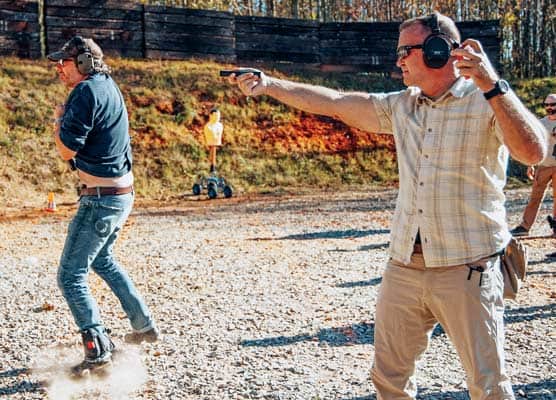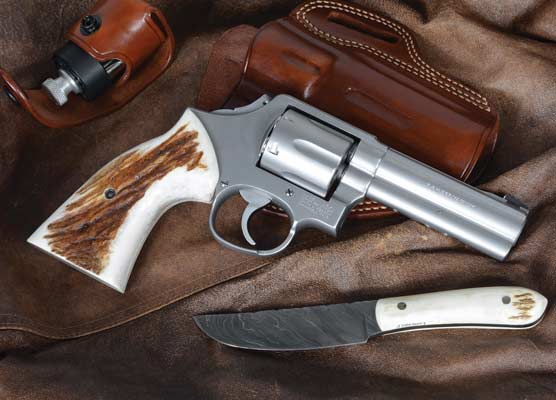The Long, Short And Round Of It
Dave Likes Wheelguns, And They Like Him, Too
One of my colleagues in Florida who has been a semi-auto guy probably from day one admits he’s not that adept with a wheelgun, which is fine, because I’ll take his share of revolvers … and the ones with five, seven or eight chambers in the cylinder as well.
While I frequently carry a lightweight Colt Commander because it’s a good shooter and so far, it hasn’t let me down, I like revolvers, whether single- or double-action. The one exception is I do not care for D/A-only revolvers, especially ones featuring bobbed hammers. (If God didn’t want us to thumb cock a D/A revolver now and then, he wouldn’t have given us the hammer spur!)
Over the course of my career, dating well back into the last century, it’s been fun to handle all kinds of round guns from Smith & Wesson, Colt, Ruger, Taurus, Rossi, Charter Arms and one or two from Hy Hunter and/or Hawes, plus a couple from Harrington & Richardson. All but a couple were wonderful shooters, and a few were simply superb in terms of accuracy, reliability, comfortable recoil and consistency. Maybe two or three were real boomers with recoil just this side of uncomfortable.
Only once have I had a revolver fail me when the bolt block/cylinder stop broke. I’ve had some disappointments with semi-autos, typically traced to the magazine or the ammunition.
The first time I competed in a handgun match at my local range some 40-plus years ago, I won it using a 6-inch Model 19 S&W with a Patridge front sight, and maybe only because I took the time to check where the bullseye was on a target with a rabbit silhouette. It was not at the shoulder, where several guys put their shots, but on the head, where my .38 Special wadcutters propelled by 3.5 grains of HP 38 cut six neat little holes over that bunny’s noggin.
Shame on me for studying a target. A few years later, I used a Colt Python 6-inch in another match. On that occasion, I believe my ammunition consisted of .38 Specials topped by 125-grain JHPs over 4.7 grains of HP 38. That load turned out to be a sizzling little small game getter.
Revolvers are as American as mom’s apple pie, baseball, hot rods, coonskin caps and “Dirty Harry” movie buffs. Elmer Keith packed a .44 Magnum. John Wayne had his Colt in the movies. James Butler “Wild Bill” Hickok carried a brace of Navy cap-and-ball revolvers with which he was said to have been deadly proficient. Where would we be if Tom Selleck’s “Matthew Quigley” hadn’t told movie audiences he “never said I didn’t know how to use one?”
History tells us Samuel Hamilton Walker, the famous Texas Ranger captain, “collaborated” with Sam Colt and the result was the big Colt Walker model, a .44-caliber fight-stopper that was, for quite some time, “the most powerful handgun in the world.” The rest, as they say, is history, and despite the earlier introduction of the Paterson, the first gun with a revolving cylinder which was a .36-caliber, the Colt Walker brought the revolver into its own. The Paterson had that strange retracting trigger visible only upon cocking the revolver, while the Walker was the “full package” with a trigger guard, stationary trigger and a great big hole in the muzzle.
Long story short, revolvers have become part of the American fabric, taking their place next to Hawken muzzleloaders, Winchester lever-action carbines, and pump-action shotguns.
Anachronism?
Have revolvers lived past their prime? Not hardly. When I was actively teaching firearms safety and personal protection classes, double-action revolvers proved their worth many times over among new students — primarily the women — who may have at first been a bit intimidated by handguns, but once they got the hang of a revolver, everything worked out.
They don’t jam. They don’t require big muscles or strong hands to cycle a slide and all one requires to keep working is loose ammunition. There’s no magazine to lose or required to make them function, which makes them the logical choice to carry in the backcountry. When I’m off the pavement, I’m almost invariably armed with a revolver, even if there’s a semi-auto pistol in the truck. They are often easier for elderly people with limited strength to use for personal protection.
So much for the sales pitch and history lesson. Let’s cut to the chase.
Capable Calibers
The alleged downside of revolvers is that they do not carry as many rounds as modern semi-autos and they are slower to reload. In my experience, those problems are offset by hitting what you’re shooting at without filling the air with lead. Practice with your revolver so you don’t worry about missing a lot.
Round guns are chambered in some very capable calibers. There are the super magnums, a list that I would say includes the .500 S&W, .480 Ruger, .460 S&W, and .454 Casull, followed by the more traditional calibers such as .45 Colt, .44 Remington Magnum, .41 Remington Magnum, .44 Special, .357 Magnum, .38 Special +P, .327 Federal Magnum and .32 H&R Magnum.
Some years ago, I talked to Charter Arms about chambering their Bulldog-frame five-shot revolver in .45 Colt. It was a handful, but in the final analysis, it delivered the goods.
One gets the most out of all these calibers through handloading, and there are plenty of suggested loads in various manuals, with wide choices of propellants and bullet weights and styles. I have personally anchored three deer with two different revolvers in .41 Magnum using 210-grain JHPs launched with either 2400 or H110 — my two favorite propellants for magnum handgun cartridges — and other people have brought down various big game animals with other calibers mentioned here.
For the .32 H&R Magnum, originally introduced by Harrington & Richardson and Federal back in 1983, I’ve found an accurate load using a 100-grain JHP over 10 grains of H110, which is a pretty snappy round, but out of my little Ruger Single-Six fixed-sight revolver with a 4 5/8-inch barrel is reasonably accurate for small game hunting. The Speer No. 14 loading manual lists a maximum charge of 10.5 grains for that bullet, but I’ve never felt the need to go that hot, and a couple of times I’ve tested other revolvers chambered for the .32 H&R or .327 Federal Magnum (which accommodates the shorter cartridge), my loads have worked just fine.
The shortest barrel length I’ve ever used in .357 Magnum is 2 ½-inches. Back in the last century, Colt offered the original Python with that barrel length, and so did S&W with the original Model 19 beginning in 1963 as a standard production option, and both were wonderful guns. Today, the “new and improved” Python is available with a 3-inch barrel, which is just as concealable.
At 2.5 inches, the .357 Magnum will not deliver the full punch as if the bullet was launched from a 4- or 6-inch tube, but it I still a fairly accurate platform and will stop a fight.
Final Thoughts
The revolver is part of America’s history, and it has saved a lot of lives over the years. Of course, it has brought an abrupt end for some folks down through history who had it coming.
As a modern hunting tool, the wheelgun is reliable and accurate, and today’s models are probably the best ever thanks to modern advances in metallurgy, new calibers, bullets and propellants.
As a defensive tool, the round gun has proven itself for a couple of hundred years in virtually all environments. I carry a sixgun when I’m in the wilds because all one needs to make it work is loose ammunition, whereas a semi-auto doesn’t work well without a functional magazine.
Serious handgunners should have at least one revolver. One never knows when it could be the only piece of emergency survival equipment at hand. In my case, let’s just say I got carried away!








